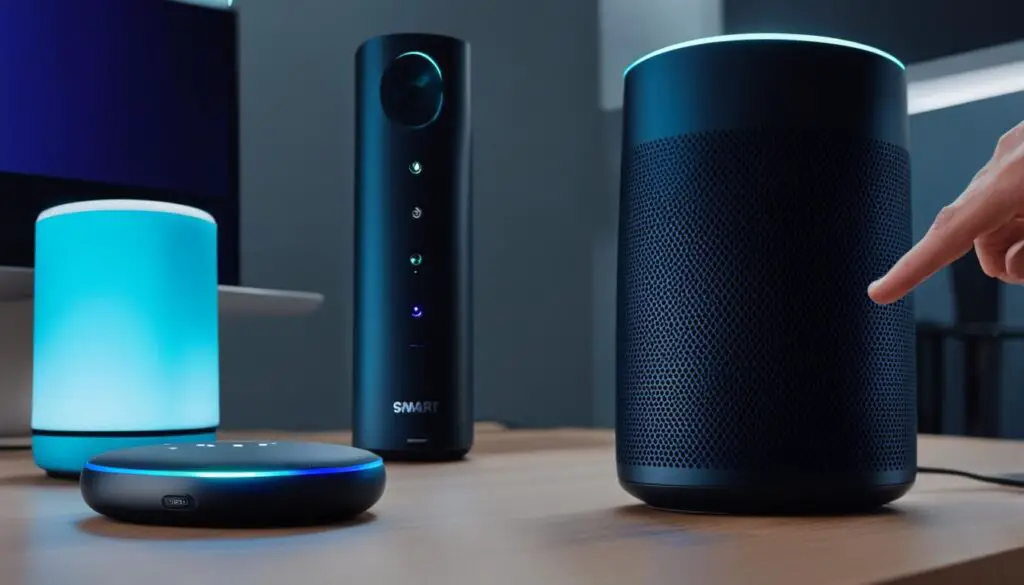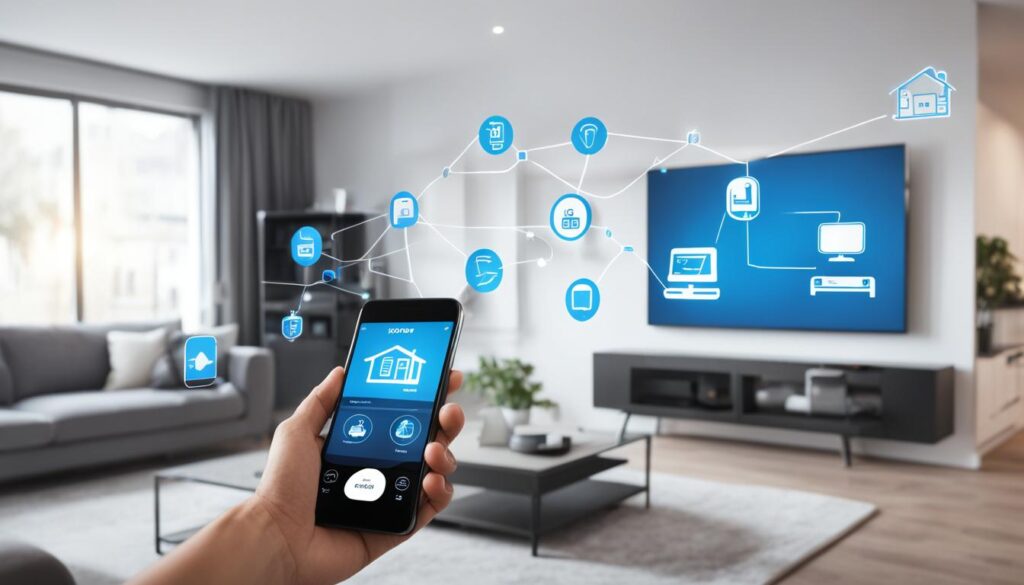Welcome to the beginner’s guide on building a simple smart home network! In today’s tech-driven world, creating a smart home network can enhance your living experience by bringing convenience, efficiency, and automation into your home. By connecting various smart devices and integrating them into a centralized control system, you can transform your house into a smart home.
In this guide, I will walk you through the process of building a basic smart home network step by step. Whether you’re a tech enthusiast or a beginner looking to explore the world of smart homes, this guide will provide you with the knowledge and guidance you need to get started. Let’s dive in!
Table of Contents
Key Takeaways:
- Building a smart home network brings convenience, efficiency, and automation to your home.
- Smart devices are the building blocks of a smart home network.
- Choose a smart home hub or smart speaker that is compatible with your devices and voice assistants.
- Setting up your smart home hub or smart speaker involves configuring the device and connecting it to your Wi-Fi network.
- Integrating smart devices into your network requires following manufacturer instructions and connecting them to your hub or speaker.
Understanding Smart Home Devices
Smart home devices play a crucial role in building a robust smart home network. They come in various types and offer a range of functionalities, enhancing convenience, comfort, and security in your home environment. Let’s explore some popular smart devices that can elevate your smart home experience.
Smart Lights
Smart lights provide customizable lighting options, allowing you to adjust brightness, color, and ambiance to suit your preferences. With the ability to control lights remotely through a smartphone app or voice commands, you can create personalized lighting scenes and schedules for different rooms.
Smart Thermostats
Smart thermostats enable you to regulate temperature settings in your home with ease. They learn your heating and cooling preferences over time and can automatically adjust to optimize energy efficiency. By connecting smart thermostats to your home network, you can control temperature settings remotely and create energy-saving schedules.
Smart Speakers
Smart speakers serve as the central control hub for your smart home network. With built-in voice assistants like Amazon Alexa or Google Assistant, they allow you to control various smart devices using voice commands. Additionally, smart speakers can stream music, answer questions, and provide information, making them a versatile addition to your home.
Smart Security Cameras
Smart security cameras provide enhanced home security and peace of mind. They offer features like motion detection, live streaming, and two-way audio, allowing you to monitor your home remotely. By integrating smart security cameras into your smart home network, you can receive real-time alerts and access footage from anywhere.
Smart Plugs
Smart plugs convert ordinary devices into smart ones, enabling you to control them remotely. By plugging devices like lamps or coffee makers into smart plugs, you can turn them on or off using a smartphone app or voice commands. Smart plugs help you save energy by eliminating standby power consumption.
Smart Locks
Smart locks offer keyless entry and advanced security features for your home. They allow you to lock and unlock your doors remotely using a smartphone app or biometric authentication. With features like temporary access codes and activity logs, smart locks provide convenience and control over your home’s security.
Smart Switches
Smart switches provide intelligent lighting control by replacing your traditional light switches. They offer features such as dimming, scheduling, and voice control, allowing you to customize your lighting experience. Smart switches can be integrated into your smart home network for seamless control.
Smart Sensors
Smart sensors detect changes in their environment and trigger actions accordingly. They can monitor factors like motion, temperature, humidity, and occupancy. By integrating smart sensors into your smart home network, you can automate tasks such as turning on lights when someone enters a room or adjusting the thermostat based on room occupancy.
Understanding the different types of smart devices available empowers you to make informed choices when building your smart home network. Each device offers unique functionalities that contribute to a seamless and efficient smart home experience.
Check out the table below for a summary of the different types of smart home devices:
| Smart Home Device | Functionality |
|---|---|
| Smart Lights | Customizable lighting options, remote control, scheduled lighting scenes |
| Smart Thermostats | Temperature regulation, energy optimization, remote control |
| Smart Speakers | Central control hub, voice commands, music streaming, information access |
| Smart Security Cameras | Home monitoring, motion detection, real-time alerts, remote access to footage |
| Smart Plugs | Remote control of devices, energy-saving features |
| Smart Locks | Keyless entry, advanced security features, remote control |
| Smart Switches | Intelligent lighting control, dimming, scheduling, voice control |
| Smart Sensors | Environmental monitoring, automation triggers |
Choosing a Smart Home Hub or Smart Speaker
When building a smart home network, one of the most important decisions you’ll need to make is selecting the right smart home hub or smart speaker. This device serves as the central control system that connects and manages all your smart devices. It enables seamless communication and allows you to control the devices through voice commands or a mobile app.
When choosing a smart home hub or smart speaker, there are several factors to consider:
Compatibility with Smart Devices
Ensure that the smart hub or speaker you choose is compatible with the smart devices you plan to integrate into your network. Some devices may only work with specific hubs or speakers, so it’s essential to verify compatibility before making a purchase.
Features and Capabilities
Each smart home hub or speaker comes with its unique features and capabilities. Some models offer advanced automation options, while others focus more on voice control. Consider your specific needs and preferences to select a device that aligns with your requirements.
Integration with Voice Assistants
If you prefer using voice commands to control your smart home devices, make sure the hub or speaker integrates well with popular voice assistants like Amazon Alexa or Google Assistant. This integration will allow you to control your devices conveniently and effortlessly through voice commands.
By carefully considering these factors, you can choose a smart home hub or smart speaker that meets your needs and seamlessly integrates into your smart home network.
| Smart Home Hub | Smart Speaker |
|---|---|
| Acts as the central control system for your smart home network | Combines smart speaker functionality with smart home control capabilities |
| Enables seamless communication between smart devices | Allows you to control devices through voice commands or a mobile app |
| May offer advanced automation options | Provides integration with popular voice assistants |
| Compatible with a wide range of smart devices | Helps create a more immersive audio experience |
Setting Up Your Smart Home Hub or Smart Speaker
Setting up a smart home hub or smart speaker is an essential step in building your smart home network. This process allows you to configure the device and connect it to your Wi-Fi network, enabling seamless communication between your smart devices. To successfully set up your smart home hub or smart speaker, follow these steps:
Step 1: Download the Manufacturer’s App
The first step is to download the app provided by the manufacturer of your smart home hub or smart speaker. This app will serve as the primary interface for setting up and controlling your device. You can find the app on the Apple App Store or Google Play Store, depending on your mobile device’s operating system.
Step 2: Create an Account
Once you have downloaded the app, create an account using your email address or phone number. This account will be used to personalize your smart home hub or smart speaker and enable remote access to your device.
Step 3: Follow On-Screen Instructions
Launch the app and follow the on-screen instructions provided by the manufacturer. These instructions will guide you through the initial setup process, including connecting your smart home hub or smart speaker to your Wi-Fi network.
Step 4: Connect to Other Devices
In some cases, you may need to connect your smart home hub or smart speaker to other devices during the setup process. This could include linking your device to your smartphone, tablet, or computer to enable initial configuration and integration.
Step 5: Configure Device Settings
Once your smart home hub or smart speaker is connected to your Wi-Fi network, you can proceed to configure the device settings. This may include setting up voice recognition, adjusting audio preferences, or personalizing the device’s behavior according to your preferences.
Follow these steps carefully, as they will ensure a smooth and successful setup of your smart home hub or smart speaker. Once the setup is complete, your smart home network will be ready to integrate and control your smart devices effectively.

Integrating Smart Devices into Your Network
Now that your smart home hub or smart speaker is set up, it’s time to bring your smart devices into the mix. Integrating your smart devices into your network is a crucial step in building a fully functional smart home system. This process allows you to connect and control your devices seamlessly within a centralized hub or speaker.
To begin integrating your smart devices, follow these steps:
- Download the manufacturer’s app for each smart device you wish to integrate.
- Open the app and follow the on-screen instructions to connect the device to your home network.
- Ensure that the device is recognized and controllable through your smart home hub or smart speaker.
The integration process may vary depending on the brand and type of smart devices you own. However, most manufacturers provide detailed instructions to guide you through the device setup and integration. If you encounter any difficulties, refer to the manufacturer’s documentation or customer support for assistance.
Benefits of Device Integration
Integrating your smart devices into your network offers several advantages:
- Centralized Control: With all your devices connected to a single hub or speaker, you can control them conveniently through a single interface or voice commands.
- Automation Possibilities: Device integration enables automation features, allowing you to create custom routines and schedules to enhance the functionality of your smart home network.
- Enhanced Efficiency: By integrating devices, you can streamline operations and optimize energy usage, leading to a more efficient and sustainable smart home environment.
As you integrate your devices, take the time to explore the features and capabilities of each device. Familiarize yourself with the control options available through your smart home hub or smart speaker to maximize the benefits of your smart home network.
With your smart devices successfully integrated into your network, you are now ready to unleash the full potential of your smart home system. Discover the convenience, comfort, and efficiency that can be achieved by taking control of your interconnected devices.

Image: An illustration of smart devices connected to a centralized hub.
Creating Automation and Control Systems
Automation is a key feature of a smart home network that allows you to enhance the efficiency and convenience of your everyday life. By setting up automation, you can streamline tasks and control your smart devices with ease. In this section, I will guide you through the process of creating automation and control systems in your smart home network.
Setting Up Rules and Triggers
To begin creating automation in your smart home network, you’ll need to set up rules and triggers. Rules define the conditions under which specific actions should occur, while triggers initiate the actions based on those conditions.
Let’s say you want your lights to turn on automatically when you enter a room. You can set up a rule that detects motion using smart motion sensors and a trigger that activates the lights when motion is detected. This way, you don’t have to manually switch on the lights every time you enter a room.
Similarly, you can set up rules and triggers to adjust the thermostat based on your schedule, lock the doors when you leave, or even initiate a morning routine that includes turning on the coffee machine and playing your favorite music.
Connecting Devices and Defining Actions
Once you have defined your rules and triggers, the next step is to connect your devices and define the actions they should take. This step involves integrating your devices into a centralized control system, such as a smart home hub or smart speaker.
Most smart home hubs or speakers come with companion apps that allow you to connect and manage your devices. Through these apps, you can assign specific actions to your devices based on the rules and triggers you have set up.
For example, you can connect your smart lights, thermostat, and security system to your smart home hub. Then, you can define actions such as turning on the lights, adjusting the thermostat temperature, and activating the security system when specific triggers are met.
Optimizing Your Smart Home Network
To optimize your smart home network, it’s crucial to regularly review and fine-tune your automation and control systems. This may involve revisiting your rules and triggers to ensure they align with your evolving needs and preferences.
Additionally, you can explore advanced automation features available in some smart home platforms. These features may include scheduling recurring tasks, creating conditional rules, or integrating third-party services to further enhance the functionality of your smart home network.
Remember, the goal of automation in a smart home network is to simplify your life and make it more convenient. Take the time to experiment and customize your automation settings to suit your unique lifestyle and preferences.
| Benefits of Automation in a Smart Home Network | Examples |
|---|---|
| Convenience | Automatically turning on lights when entering a room |
| Energy efficiency | Adjusting the thermostat based on occupancy |
| Security | Locking doors and activating security cameras when leaving home |
| Customization | Creating personalized routines for your daily activities |
Expanding Your Smart Home Network
As you become more familiar with your smart home network and its capabilities, you may want to expand it by adding more smart devices and integrating additional features. This could include adding smart security systems, smart appliances, or even integrating voice control with virtual assistants like Amazon Alexa or Google Assistant. The scalability of your smart home network will depend on the capabilities of your smart home hub or smart speaker and the compatibility of the devices you wish to add.
To expand your smart home network, follow these steps:
- Identify the devices you want to add to your network. Consider your specific needs and preferences. For example, you might want to add smart security cameras to enhance your home security or smart plugs to control appliances remotely.
- Check the compatibility of the devices with your smart home hub or smart speaker. Some devices may require specific protocols or connectivity options to integrate with your existing network.
- Follow the manufacturer’s instructions to add the devices to your network. This typically involves downloading the manufacturer’s app, creating an account, and following the on-screen setup instructions.
- Connect the devices to your smart home hub or smart speaker using the app or voice commands. Ensure that they are recognized and controllable through your central control system.
- Test the integration and functionality of the added devices. Make sure they work seamlessly with your existing smart devices and follow any specific instructions or guidelines provided by the manufacturer.
By expanding your smart home network, you can enjoy the benefits of a more connected and automated home environment. Whether it’s controlling your lights, adjusting your thermostat, or monitoring your home security, adding new devices to your network opens up a world of possibilities for customization and convenience.
Adding Voice Control with Virtual Assistants
An exciting way to enhance your smart home network is by integrating voice control with virtual assistants like Amazon Alexa or Google Assistant. These virtual assistants allow you to control your smart devices using voice commands, creating a hands-free and intuitive experience.
To add voice control to your smart home network, follow these steps:
- Ensure that your smart home hub or smart speaker is compatible with the virtual assistant of your choice. Most smart hubs or speakers support popular virtual assistants like Amazon Alexa or Google Assistant.
- Set up the virtual assistant by following the manufacturer’s instructions. This usually involves downloading the virtual assistant app, linking it to your smart home hub or smart speaker, and configuring your preferences.
- Connect your smart home devices to the virtual assistant app using the provided integration options. This may require linking your accounts and granting permissions for device control.
- Test the voice control functionality by issuing voice commands to the virtual assistant. You can ask to turn on/off lights, adjust the thermostat, or perform other actions supported by your smart devices.
With voice control, you can effortlessly manage your smart home network with just your voice, adding a new level of convenience and ease to your smart home experience.
Conclusion
Building a basic smart home network is an accessible and rewarding endeavor that can transform your everyday living experience. By following the steps outlined in this guide, you can establish a simple smart home network that enhances convenience, energy efficiency, and security in your home.
To start, choose smart devices that suit your needs and preferences, ensuring compatibility with your chosen smart home hub or speaker. Consider devices such as smart lights, thermostats, security cameras, and sensors to enhance various aspects of your home.
Next, set up a compatible smart home hub or speaker, which will act as the central control system for your network. Connect it to your Wi-Fi network and integrate your chosen smart devices into a centralized control system. This will allow you to control and manage all your devices through voice commands or a mobile app.
Finally, explore automation and expansion possibilities to maximize the potential of your smart home network. Set up automation rules and routines that suit your lifestyle and preferences, allowing your smart devices to work together seamlessly. As you become more familiar with your network, consider adding more smart devices and integrating additional features to further enhance your smart home experience.
With a little knowledge and effort, you can create a functional and efficient smart home network that simplifies your life. Enjoy the convenience, energy efficiency, and security provided by your smart home network, and make the most out of this exciting technology in your everyday living.
FAQ
What is a smart home network?
A smart home network is a system of interconnected smart devices that allow you to control and automate various aspects of your home, such as lighting, temperature, security, and entertainment, through a centralized hub or smart speaker.
What are smart home devices?
Smart home devices are a diverse range of products that can be connected to a smart home network. They include smart lights, thermostats, security cameras, plugs, locks, switches, and sensors, among others.
How do I choose a smart home hub or smart speaker?
When selecting a smart home hub or smart speaker, consider factors such as compatibility with your chosen smart devices, features and capabilities offered, and integration with popular voice assistants like Amazon Alexa or Google Assistant.
How do I set up a smart home hub or smart speaker?
To set up a smart home hub or smart speaker, you typically need to download the manufacturer’s app, create an account, and follow the on-screen instructions for device setup. You may also need to connect it to your Wi-Fi network and other devices for initial configuration.
How do I integrate smart devices into my network?
Integrating smart devices into your network involves connecting them to your smart home hub or smart speaker using the manufacturer’s app or on-screen instructions. This ensures that the devices are recognized and controllable through the hub or speaker.
How do I create automation and control systems in a smart home network?
To create automation and control systems, you need to set up rules and triggers through your smart home hub or smart speaker’s app. This includes connecting devices together and defining actions based on specific conditions, such as turning on lights when you enter a room or adjusting the thermostat based on your schedule.
Can I expand my smart home network?
Yes, you can expand your smart home network by adding more smart devices and integrating additional features. This may include adding smart security systems, smart appliances, or integrating voice control with virtual assistants like Amazon Alexa or Google Assistant.
How do I build a basic smart home network?
To build a basic smart home network, choose smart devices that suit your needs, set up a compatible hub or smart speaker, integrate devices into a centralized control system, and explore automation and expansion possibilities.


